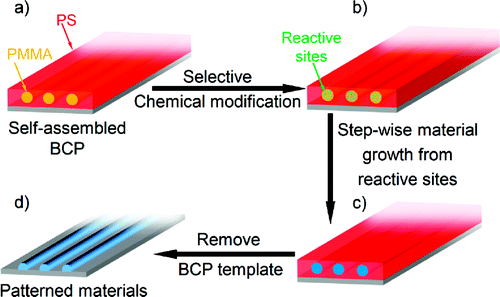| Nanostructured materials having well defined patterns over macroscopic length scales are of interest for a range of emerging applications in energy, sensing, nanomedicine, data storage, and electronics. Recently Peng et. al. have introduced a route to the formation of nanostructured materials by sequential infiltration synthesis (SIS). The SIS method uses BCP domains as a fixed template to control the nanofeatures of a range of materials by gas phase processes having controlled surface reactions similar to atomic layer deposition (ALD), a cyclic gas phase process for depositing thin films. |
Reviewed by Jeff Morse, PhD, National Nanomanufacturing Network
- Peng Q, Tseng Y, Darling SB, Elam JW. 2011. A Route to Nanoscopic Materials via Sequential Infiltration Synthesis on Block Copolymer Templates. ACS Nano. 5(6):4600-4606. doi:10.1021/nn2003234
Nanostructured materials having well defined patterns over macroscopic length scales are of interest for a range of emerging applications in energy, sensing, nanomedicine, data storage, and electronics. Templates or scaffolds to create such materials patterns have been demonstrated with techniques including nanoimprint lithography (NIL) and self-assembly of block copolymer (BCP) thin films. The latter offers a versatile approach to control of feature size and morphology through tuning of the molecular weight and chemical composition of the BCP melt. To extend the range of materials and functionalities from which such nanofeatures can be obtained, self-assembled BCP templates have been utilized to synthesize other patterned nanomaterials by gas or liquid phase methods. These methods typically have limited scalability due to control of fabrication steps, process complexity, and the use of specific catalysts to control the nanoreactions.

Using the SIS method the authors were able to demonstrate the synthesis of silicon dioxide (SiO2), zinc oxide (ZnO), and tungsten (W) nanostructures from PS-b-PMMA cylindrical templates having both horizontal and vertical morphologies using TMA precursor exposures. As the SIS process is a balance between reactant diffusion and nucleation, the growth of the nanoscopic structures was controlled by process temperature and pressure, partial pressure of the gas reactants, and cycle times. In this manner, replication of the template patterns was achieved for each material. Control of pattern feature size was not limited by the initial template features, but by the total number of SIS cycles and initial amount of catalyst precursor material present. Therefore a method of creating a range of nanostructured inorganic materials has been introduced. The method exploits the chemistries and foundations provided by existing ALD tool infrastructures, enabling a route to the synthesis of patterned designer materials having controlled features, order, and composition. Further extension of this method will be achieved through the engineered design of BCP systems and SIS process parameters.
Figure posted with permsision from Peng Q, Tseng Y, Darling SB, Elam JW. 2011. A Route to Nanoscopic Materials via Sequential Infiltration Synthesis on Block Copolymer Templates. ACS Nano. 5(6):4600-4606. doi:10.1021/nn2003234. Copyright 2011 American Chemical Society.
